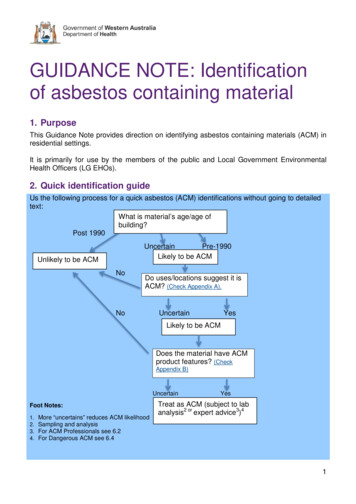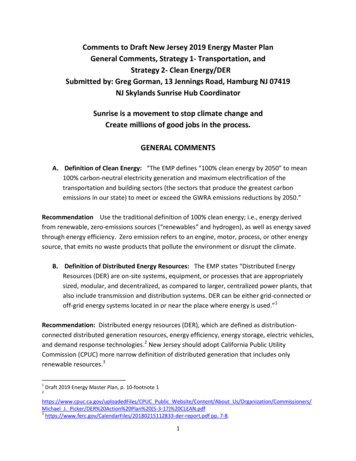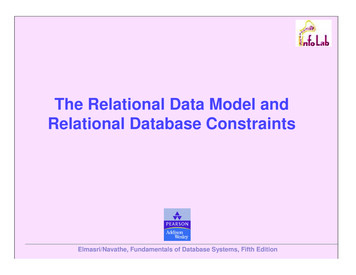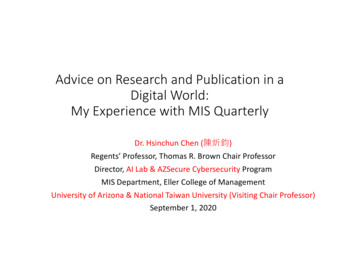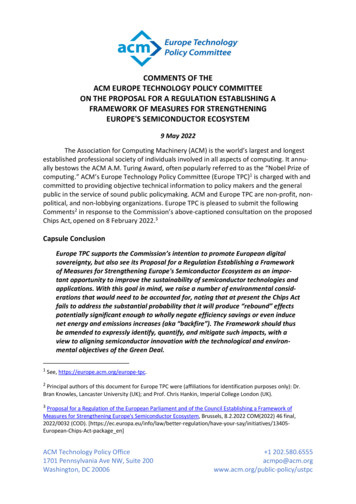
Transcription
COMMENTS OF THEACM EUROPE TECHNOLOGY POLICY COMMITTEEON THE PROPOSAL FOR A REGULATION ESTABLISHING AFRAMEWORK OF MEASURES FOR STRENGTHENINGEUROPE'S SEMICONDUCTOR ECOSYSTEM9 May 2022The Association for Computing Machinery (ACM) is the world’s largest and longestestablished professional society of individuals involved in all aspects of computing. It annually bestows the ACM A.M. Turing Award, often popularly referred to as the “Nobel Prize ofcomputing.” ACM’s Europe Technology Policy Committee (Europe TPC)1 is charged with andcommitted to providing objective technical information to policy makers and the generalpublic in the service of sound public policymaking. ACM and Europe TPC are non-profit, nonpolitical, and non-lobbying organizations. Europe TPC is pleased to submit the followingComments2 in response to the Commission’s above-captioned consultation on the proposedChips Act, opened on 8 February 2022.3Capsule ConclusionEurope TPC supports the Commission’s intention to promote European digitalsovereignty, but also see its Proposal for a Regulation Establishing a Frameworkof Measures for Strengthening Europe's Semiconductor Ecosystem as an important opportunity to improve the sustainability of semiconductor technologies andapplications. With this goal in mind, we raise a number of environmental considerations that would need to be accounted for, noting that at present the Chips Actfails to address the substantial probability that it will produce “rebound” effectspotentially significant enough to wholly negate efficiency savings or even inducenet energy and emissions increases (aka “backfire”). The Framework should thusbe amended to expressly identify, quantify, and mitigate such impacts, with aview to aligning semiconductor innovation with the technological and environmental objectives of the Green Deal.1See, https://europe.acm.org/europe-tpc.2Principal authors of this document for Europe TPC were (affiliations for identification purposes only): Dr.Bran Knowles, Lancaster University (UK); and Prof. Chris Hankin, Imperial College London (UK).3Proposal for a Regulation of the European Parliament and of the Council Establishing a Framework ofMeasures for Strengthening Europe's Semiconductor Ecosystem, Brussels, 8.2.2022 COM(2022) 46 final,2022/0032 (COD). ackage en]ACM Technology Policy Office1701 Pennsylvania Ave NW, Suite 200Washington, DC 20006 1 /ustpc
OverviewEurope TPC recognises the geopolitical and economic factors motivating the creationof semiconductor production facilities in Europe, while at the same time noting thatenvironmental destabilisation (viz. climate change and extraction of critical rare earthmetals) also poses an existential threat to Europe’s resilience and reduces geopoliticalstability. These conflicting concerns need to be carefully balanced.Given Europe’s leadership on environmental policy, the present proceeding affordsan opportunity to ultimately improve both the output and fundamental sustainability of thesemiconductor industry. To meet both goals, however, the proposed Framework also mustpromote scrutiny and regulation of the environmental impacts of semiconductorproduction.To that end, in assessing how best to finalise the proposed Chips Act, Europe TPCurges the Commission, Council, and European Parliament to consider the following observations and supporting data relating to environmental consequences of semiconductorproduction both within and outside the Information and Communications Technology (ICT)sector that are presently unaddressed by the proposed legislative Act:Direct Impacts within the ICT SectorThe Chips Act may lead to rebound effects which are significant enough to induce backfire.Semiconductor manufacture is responsible for the majority of ICT’s direct emissions: ICT is unlike other industries, such as construction, automotive, aviation, for whichthe lifetime energy use is dominated by operational energy (use phase).4,5 As chips advance, their manufacture incurs a greater environmental impact.6 The Chips Act acknowledges that manufacture of semiconductors has a carbonfootprint, but i) underestimates the proportional share of production phase energy,and ii) overestimates the energy saved by use of more efficient chips. These use phase efficiencies are more than cancelled out by the rising energyintensity of manufacture of advanced semiconductors – particularly when incremental efficiency improvement resulting from investment in R&D necessitates thedisposal of obsolescent chips long before the use phase energy savings accrue.4Williams, E. (2011). Environmental effects of information and communications technologies. Nature,479(7373), 354-358.5Gupta, U., Kim, Y. G., Lee, S., Tse, J., Lee, H. H. S., Wei, G. Y., . & Wu, C. J. (2022). Chasing carbon: The elusiveenvironmental footprint of computing. IEEE iantcarbon-footprintACM Technology Policy Office1701 Pennsylvania Ave NW, Suite 200Washington, DC 200062 1 /ustpc
The Act’s stated requirement that chips meet “energy efficiency requirements”could create a moving target (set on a rolling basis by the state-of-the-art) thatdrives obsolescence. Investment in new European production facilities entails additional up-frontenvironmental impacts which will add to the lifetime energy attributable tosemiconductor manufacturing (production phase).Semiconductor fabrication creates hazardous waste by-products that pose human healthrisks and threaten ecosystems if not properly managed:7 The Chips Act does not mention any hazardous waste by-products except for “fluorinated greenhouse gasses”; nor does it set out clear requirements for handlinghazardous waste. The Chips Act downplays key opportunities for extracting critical rare earth metalsfrom industry by-products and electronic waste.8 The Chips Act further lacks a strong mandate for “cutting edge” semiconductors tobe designed to better enable recyclability and thus reduce environmental impacts ofthe disposal phase.Indirect Impacts within the ICT SectorThe Chips Act will almost certainly induce backfire.Semiconductor innovation is a key driver of increased energy demand and a rising ICTcarbon footprint: Approaching the physical limits of Moore’s law9 and Dennard’s law10 will necessitatethe use of parallel computing to improve performance. This will likely result in astrong growth in energy demand.7Shen, C. W., Tran, P. P., & Minh Ly, P. T. (2018). Chemical waste management in the US semiconductorindustry. Sustainability, 10(5), 1545.8Gaustad, G., Williams, E., & Leader, A. (2021). Rare earth metals from secondary sources: review of potentialsupply from waste and by-products. Resources, Conservation and Recycling, 167, 105213.9“The statement that the number of transistors that can be placed on an integrated circuit doubles every twoyears. This statement was first made by Gordon Moore (1929– ), the president of Intel, in 1965 and it hasremained valid for the first fifty years of the existence of integrated circuits. However, there are variousreasons for thinking that this will come to an end in the future. For example, as circuits become smaller, thequantum effects associated with individual atoms and electrons become more significant.” See,www.oxfordreference.com10According to Semiconductor Engineering, “Dennard’s Law states that as the dimensions of a device godown, so does power consumption. While this held, smaller transistors ran faster, used less power, and costless. But there was a limit to how long this would last. Smaller devices with thinner dielectrics and shorterchannels are more prone to leakage. Leakage, while negligible for much of the industry’s history and ignored inDennard’s original paper, now approaches the same order of magnitude as the circuit’s dynamic power.” See,www.semiengineering.comACM Technology Policy Office1701 Pennsylvania Ave NW, Suite 200Washington, DC 200063 1 /ustpc
The Chips Act aims to increase semiconductor production to accommodateunrestrained growth in demand for computation. This rising demand forcomputation underlies continuous growth in the ICT sector’s carbon emissions,which in turn requires greater emissions reductions across the economy to meetclimate targets. To the extent that limits in semiconductor supply currently act as a constraint to (oras “brakes” on) some of these excesses, the Act’s investment in semiconductorproduction will necessarily increase the rate of growth of ICT’s emissions in Europe.Indirect Impacts across the EconomyThe Chips Act will lead to significant rebounds (if not backfire) if technology is leveraged inpursuit of economic growth to the exclusion of environmental considerations.Semiconductor innovation enables new capabilities that induce new energy demands: The Chips Act rightly notes that, e.g., 5G enables expansion of Internet of Things andedge computing technologies, which in turn drives the need for more and moreadvanced semiconductors. This is a useful illustration of the positive feedbackbetween innovation and growth in markets. Digital infrastructure growth drivesinnovation in semiconductors; in turn, innovation in semiconductors can beexpected to enable further infrastructure growth, driving greater demand in anendless cycle, undermining environmental gains that could be enabled by ICTs. Ultra-low power energy efficient processors are critical enablers of transformation inhow societal needs are met. The Chips Act frames these transformations as massively economically advantageous to Europe. We note that environmental costs arenot fully valued in the market, although the EU Emissions Trading System is a welcome step towards this. Taking the long view, if constraints (e.g., carbon, emissions)become priced, the economic gains resulting from unrestrained growth may bematerially overestimated.RecommendationsSemiconductor innovation will be critical to enabling Europe to achieve its environmentalgoals but succeeding will require that innovation be steered into alignment with the GreenDeal.1111See ACM’s Europe Technology Policy Committee’s formal comments in response to the Green ublic-policy/europe-tpc-green-deal-comments.pdfACM Technology Policy Office1701 Pennsylvania Ave NW, Suite 200Washington, DC 200064 1 /ustpc
There is a need for investment in innovation which will deliver reductions in the directenvironmental impacts of semiconductor production and disposal: A stronger focus on lower power consumption (specifically maximum TDP)12 in chipdevelopment would be very desirable to help mitigate rebound. In conformity with the Circular Economy Action Plan,13 a portion of Europe’ssemiconductor investment should include funding of materials and processinnovation that increases the recovery of materials from electronic waste andimproves recyclability of chips, with a view to mandating recyclability requirements. While creating facilities for the manufacture of semiconductors, Europe should alsotake responsibility for their disposal as a matter of social justice14 and to incentiviseinnovation of more responsible practices. Funding should be prioritised for companies which have made the strongestenvironmental commitments regarding renewable energy, water, and waste.In conformity with the EU Emissions Trading System and in accordance withinternational climate agreements (viz. European commitments at COP26), rigorousaccounting of emissions impacts is needed: Projections of the efficiency savings enabled by semiconductor innovation shouldaccount for the full lifecycle (production, use, and disposal) of the semiconductorsthemselves. Accounting for the changing carbon intensity of energy, these projections shouldinclude implications for carbon emissions impacts, with a view to aligning these withemissions reductions timelines. All initiatives funded through Chips Act investments should be required to accountfor their real (actual) direct emissions as a condition of their funding. This will enablerefinement of projections against emissions reductions targets. A working group and/or oversight body should be created in Europe to monitor andaddress issues of rebound and backfire as identified above.12“Thermal Design Power” is defined, for example, by Intel (a major chip manufacturer) as “powerconsumption under the maximum theoretical y/circular-economy-action-plan en14Electronic waste disposal involves exposure to harmful chemicals and dangerous working conditions, theconsequences of which are disproportionately felt by poor and racially marginalised people.ACM Technology Policy Office1701 Pennsylvania Ave NW, Suite 200Washington, DC 200065 1 /ustpc
In conformity with the Green Deal, there must be up-front investment technologieswhich enable sustainable transformation across the economy: Clearer specification is needed regarding the use of chips to enable concreteenvironmentally beneficial transitions as detailed in the Green Deal. For example, asthe Chips Act notes, more semiconductors are needed to enable the transition toelectric vehicles; they are also needed for photovoltaic modules, which are essentialto Europe’s climate strategy. Each of these concrete items should include specification of a minimum viableproduct (necessary power and performance characteristics) needed to enable thegiven sustainability improvement. This can be used as a fixed target to preventunnecessary obsolescence and thus net the efficiency gains delivered by the moreadvanced semiconductors. European technology policy should challenge unrestrained demand for computationdue to its incompatibility with environmental commitments. Investment in semiconductor innovations or applications which spur environmentally disadvantageous economic growth should be limited. Investment shouldprioritise profitability of attending to the demands entailed by a more sustainableeconomy.ConclusionEurope TPC strongly supports semiconductor innovation, recognising its potential tofundamentally revolutionise society. We also recognise our responsibility to ensure thatinnovation delivers social and environmental good. Accordingly, Europe TPC stronglyencourages harmonisation of the Chips Act with other European policy initiatives to harnessinnovation to realise a sustainable Digital Decade.ACM Technology Policy Office1701 Pennsylvania Ave NW, Suite 200Washington, DC 200066 1 /ustpc
4 ACM Technology Policy Office 1 202.580.6555 1701 Pennsylvania Ave NW, Suite 200 acmpo@acm.org




